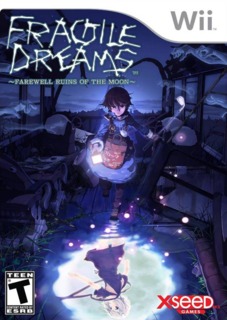An incredible concept that is marred by poor execution
Fragile, undeniably, packs quite a concept, which is made unique by a very distinct presentation. The game's blend of cell-shaded graphics, interesting color palette and character design obviously inspired by Japanese cartoons gives birth to a very appealing visual, and one that - while cheerfully contradicting the game's dark premise - ends up creating quite an impressive conflicted marriage between theme and image. The game is very successful in broadcasting a desolate sense of destruction. Throughout the adventure Seto will explore a number of different scenarios like a mall, a theme park, a train station, a hotel and more, and each one of those is tied together in their ability to portray the wreckage of a destroyed world. What is perhaps the most amazing component of that presentation is how even the tiniest objects in a room are both designed and placed carefully in order to further emphasize the feeling of abandonment.
Sadly, the game's brilliant presentation is not matched by an excellent gameplay. When dealing with exploration, Fragile absolutely soars, because it is such a big pleasure to take a good look at its world or find objects that tell stories about the people who were there at the time of the apocalypse, but more often than not the game engages in gameplay scenarios that are obviously designed to pad the adventure. At one point, for example, the game forces the character to move around a theme park chasing a character that has stolen Seto's belongings. Instead of betting in straightforward exploration, which would be far more compelling, but much shorter, the developers decided to make Seto repeatedly visit all the areas of the scenario. It is something that, along with backtracking, happens often and works against the game's sense of immersion, because it reminds people they not only are playing a game, but a game that is artificially trying to inflate its size.
While Seto explores the world, he will stumble upon a good number of varied enemies, and, as it happens in most games, combat becomes a welcome item to break the game's pace every once in a while. However, in Fragile it is not that welcome, because the game ignores something that - twelve years before its release - was established as vital for combat in a 3-D environment: a lock system. That means players will be left to manage the camera during battles, which in turn causes Seto to miss a few of his blows or even get hit unfairly simply because the camera angle did not shift fast enough or because players did not move it accurately. It is archaic and frustrating, and the only thing that makes it better is the fact that combats are really not that challenging.
To make matters worse, the game's item management is a chore. Seto has a briefcase with a few open slots where he can store weapons, healing items or mystery items - objects that can either be valuable belongings with memories attached to them, or precious metals that can be sold. In addition, he can carry extra items in his inventory. Unfortunately, switching items between the inventory and the briefcase, and discovering what exactly the found mystery item is can only be done at save points - present in the form of fires. That design leads to many situations where, for example, your character's weapon loses stamina and breaks and you have to fight with a broken weapon until you locate a save point, or where your briefcase gets so full of mystery items you have to stop, sit by the fire and examine them before moving on. While the fires are numerous, sitting by them involves watching a five-second cutscene where Seto warms himself up and mutters some pointless comment. Five seconds might not be a lot, but when summed up over the course of many hours of gameplay, it quickly becomes annoying.
Fortunately, the game is partially saved by its technical aspects. The controls work well for the most part, and the use of the flashlight is intuitive and precise. The only issues show up when Seto moves around very tight spots and the camera responds a little awkwardly, moving by jumping from one position to the other, instead of performing a smooth transition. Those situations, though, are very rare. The game also has a fantastic moody soundtrack that goes along nicely with its theme, and the cutscenes that reveal details of Seto's journey and of the game's good storyline are quite an achievement, especially in their art design, as they look like very well-produced Japanese cartoons with a greatly sensible artistic direction.
In the end, Fragile Dreams: Farewell Ruins of the Moon is a game that is very appealing in its concept and story, but that due to odd design choices and boring padding - which fails to extend the game's duration for more than six hours or so, ends up not delivering the promised product. Some gamers will find themselves so engaged by the game's world, story, graphics and soundtrack that they will find it in themselves to love the game in one way or another, but others will be too bothered by the game's conspicuous issues to get too much enjoyment out of it.

